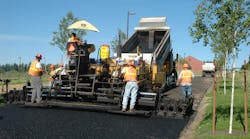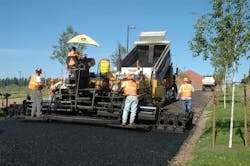According to a survey conducted by the National Asphalt Pavement Association (NAPA) under contract to the Federal Highway Administration (FHWA), record-high levels of recycled materials were used in the construction of new pavements during the 2011 construction season, to the tune of saving some 21.2 million barrels of liquid asphalt binder worth some $2.2 billion.
For this survey, NAPA polled some 203 companies with 1,091 plants in 49 states and Puerto Rico in mid-2012, while also crunching data provided by 32 state asphalt pavement associations as well to help calculate industry estimates for total tonnage.
Thus, based on that accumulated information, NAPA’s survey discerned that about 66.7 million tons of reclaimed asphalt pavement (RAP) and 1.2 million tons of reclaimed asphalt shingles (RAS) were collected in the U.S. during 2011 for use in new pavements, while roughly 19% of all asphalt produced in the country that year was made using warm-mix asphalt (WMA) technologies.
The group said that the use of RAP and RAS during the 2011 paving season is what translated into that aforementioned savings of 21.2 million barrels of liquid asphalt binder, thus keeping $2.2 billion in the taxpayers’ pocket."The way old asphalt pavements can be used to build new ones cannot be matched by any other paving material," said Mike Kvach (at right), executive director of the Asphalt Pavement Alliance. "Cities, states, and private companies should embrace the use of recycled materials and warm-mix asphalt to ensure that they get high-quality, sustainable roads and save taxpayers billions of dollars in the process."
He added that when reclaimed asphalt pavement and shingles are processed into new pavement mixtures, the liquid asphalt binder in the recycled material is reactivated, thus reducing the need for “virgin” asphalt binder.
“Using reclaimed materials also reduces demands on aggregate resources. With RAP, old roads can be effectively ‘mined’ for the raw materials needed to create their replacements,” Kvach said. “Warm-mix asphalt technologies allow asphalt pavements to be produced at lower temperatures – and that means reduced energy demands, as well as lower levels of emissions during production and paving.”
Other findings from NAPA’s survey include:
- RAP usage reached 66.7 million tons in 2011; a 7% increase from 2010 and a 19% increase from 2009.
- More than 99% of reclaimed asphalt pavement went back into new construction, pavement preservation, rehabilitation, and other paving projects.
- RAS usage also continued to climb, increasing to 1.2 million tons in 2011 — an 8% increase over 2010, and a 52.5% increase since 2009.
- In 2011, total WMA tonnage in the U.S. topped about 69 million tons – a 67% increase from 2010 and a nearly 309% increase since 2009.
"Asphalt pavements are the sustainable option for paving our nations' roads and highways. With warm mix, we can use less energy to produce high-quality pavements, and RAP and RAS allow us reuse liquid asphalt, saving costs and preserving natural resources," noted John Keating, NAPA’s current chairman and president and COO the eastern division of Oldcastle Materials Inc.
"While use of these technologies has increased dramatically, there is room to do more, and the asphalt pavement industry is ready to reach even higher levels of sustainability in road construction," he said.
Just goes to show recycling can often be a big money saver – especially for all of us taxpayers – when it comes to repairing and building the roadways that keep our economy humming.





